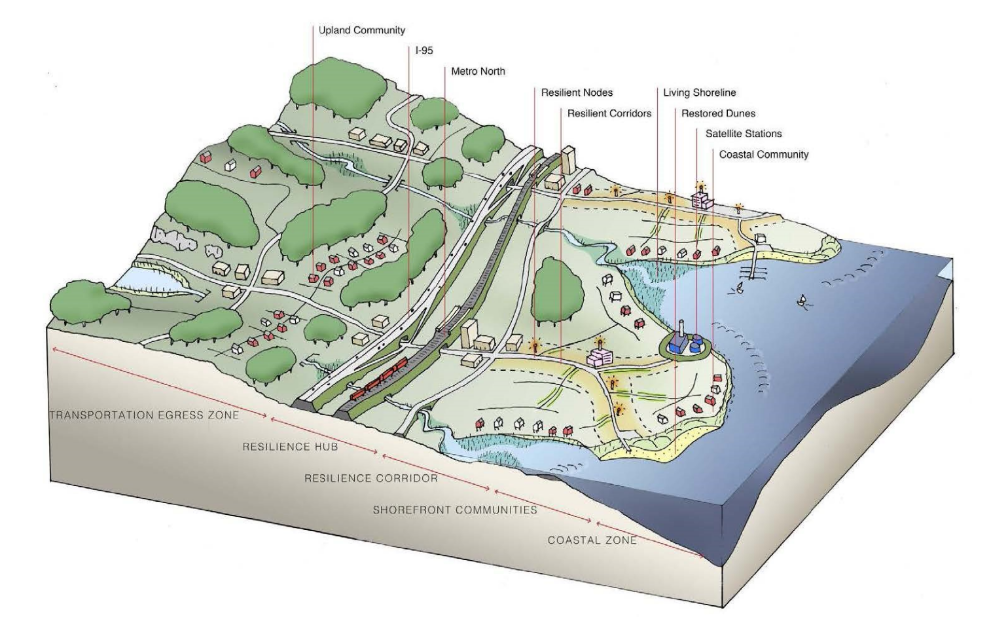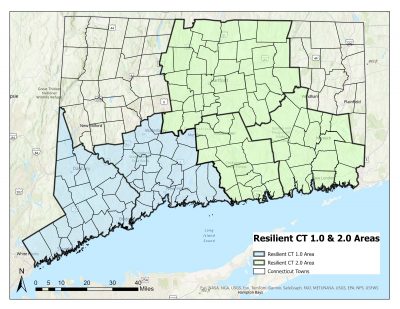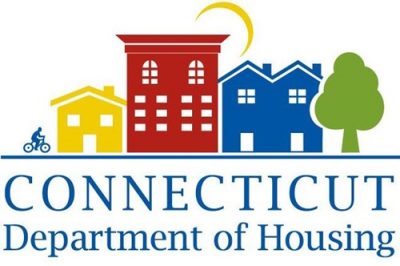What is Resilient Connecticut?
The Connecticut Institute for Resilience and Climate Adaptation (CIRCA) initiated Resilient Connecticut in 2018 as a component of the U.S. Department of Housing and Urban Development (HUD) National Disaster Resilience Competition award to the State of Connecticut, administered by the Connecticut Department of Housing. This planning and engagement process was piloted in New Haven and Fairfield Counties to address unmet recovery needs following Superstorm Sandy’s impact on Connecticut. Resilient Connecticut’s guiding principle is to establish resilient communities through forward-looking planning that incorporates community and economic development framed around transit-oriented development (TOD), critical infrastructure improvements, and conservation strategies.

 Resilient Connecticut Phase I resulted in the development of a framework to guide the planning process in Fairfield and New Haven Counties. In Phase II, CIRCA completed a regional vulnerability assessment and delineated a series of Resilience Opportunity Areas (ROARs). The 64 ROARs identified and mapped across Fairfield and New Haven Counties represent the intersection of climate induced flooding and heat risks with vulnerable populations and key regional assets. Assets include affordable housing, transportation assets, critical infrastructure, and ecological systems along with other assets that impact the long-term resilience and potential of the region. Phase III focuses on the development of location specific projects building on the ROARS, including detailed analysis with implementable concept plans. The goal of this work is to help decision-makers prepare for sea level rise and changes in flooding, precipitation, and temperature; and advance planning for the state’s resilience “project pipeline.”
Resilient Connecticut Phase I resulted in the development of a framework to guide the planning process in Fairfield and New Haven Counties. In Phase II, CIRCA completed a regional vulnerability assessment and delineated a series of Resilience Opportunity Areas (ROARs). The 64 ROARs identified and mapped across Fairfield and New Haven Counties represent the intersection of climate induced flooding and heat risks with vulnerable populations and key regional assets. Assets include affordable housing, transportation assets, critical infrastructure, and ecological systems along with other assets that impact the long-term resilience and potential of the region. Phase III focuses on the development of location specific projects building on the ROARS, including detailed analysis with implementable concept plans. The goal of this work is to help decision-makers prepare for sea level rise and changes in flooding, precipitation, and temperature; and advance planning for the state’s resilience “project pipeline.”

In 2021 and 2022 CIRCA received additional State and Federal funds to expand Resilient Connecticut from southwest Connecticut to the southeast and central areas of the state. “Resilient Connecticut 2.0” has included a statewide expansion of the Climate Change Vulnerability Index (CCVI) followed by climate adaptation project development in the communities of the SCCOG, RiverCOG, and CRCOG planning areas. For more information on Resilient Connecticut community and site-scale planning projects please visit the project viewer here.

 Funding for this project is provided by the U.S. Department of Housing and Urban Development through the Community Development Block Grant National Disaster Recovery Program, as administered by the Connecticut Department of Housing. This publication does not express the views of the Department of Housing or the State of Connecticut. The views and opinions expressed are those of the authors.
Funding for this project is provided by the U.S. Department of Housing and Urban Development through the Community Development Block Grant National Disaster Recovery Program, as administered by the Connecticut Department of Housing. This publication does not express the views of the Department of Housing or the State of Connecticut. The views and opinions expressed are those of the authors.